RED SWARM
Smart Mobility in Cities with Evolutionary Algorithms
Nowadays, cities are evolving quickly. Most citizens are living in, using the services of, or thinking about moving to cities, what is a new source of complex problems. Smart Cities is a world initiative leading to better exploit on of the resources in a city in order to offer higher level services to people. Smart cities are related to sensing the city's status and acting in new intelligent ways at different levels: people, government, cars, transport, communications, energy, buildings, neighborhoods, resource storage, etc.
This work presents an original approach to regulate traffic by using an on-line system controlled by an Evolutionary Algorithm. Our proposal uses computational spots with WiFi connectivity located at traffic lights (the Red Swarm), which are used to suggest alternative individual routes to vehicles.
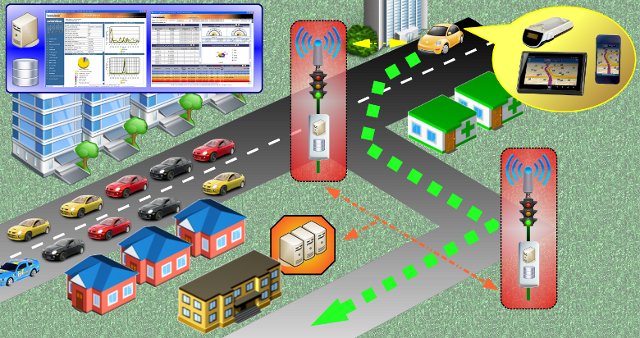
An evolutionary algorithm is also proposed in order to find a configuration for the Red Swarm spots which reduces the travel time of the vehicles and also prevents traffic jams. We solve real scenarios in the city of Malaga (Spain), thus enriching the OpenStreetMap info by adding traffic lights, sensors, routes and vehicle flows.
The result is then imported into the SUMO traffic simulator to be used as a method for calculating the fitness of solutions. Our results are competitive compared to the common solutions from experts in terms of travel and stop time, and also with respect to other similar proposals but with the added value of solving a real, big instance.
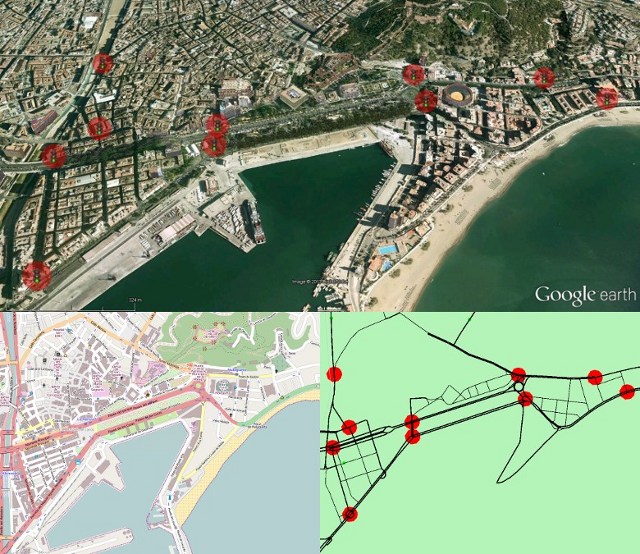
The results confirm that road traffic can be improved by using our proposal, especially in high density conditions (e.g. peak times, construction, accidents reducing the available streets, etc.).
Although the average travel time was only 4.2% better than the solution of the experts, we lowered the waiting time of the vehicles by 14.2%. That means that drivers are wasting less time (about 23 second less on average) waiting at a red light and in each traffic jam.
For preliminary results for our future work, we have tested Red Swarm in 30 extra scenarios, different from the ones analyzed here. Our proposal not only has worked in all these scenarios but has also achieved lower travel times than the experts' solution in 20 of them (66.7%).
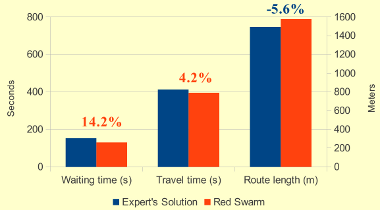
| 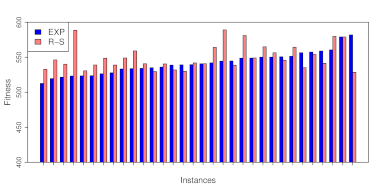
|
Red Swarm will not only provide alternative routes for every single car in the city, but will also be able to collect information from the cars (in an anonymous way) permitting local authorities to better know the on-line and historical data of the city to actually help the evolution to a modern smart city.
Publications:
Daniel H. Stolfi and Enrique Alba. Red Swarm: Smart Mobility in Cities With EAs. In: Proceeding of the Fifteenth Annual Conference on Genetic and Evolutionary Computation Conference, in GECCO '13. New York, NY, USA: ACM, 2013, pp. 1373-1380.
doi> 10.1145/2463372.2463540 | [BibTex] | [Slides] | [Files]@inproceedings{Stolfi:2013:RSS:2463372.2463540, address = {New York, NY, USA}, author = {Stolfi, Daniel H. and Alba, Enrique}, booktitle = {Proceeding of the Fifteenth Annual Conference on Genetic and Evolutionary Computation Conference}, doi = {10.1145/2463372.2463540}, isbn = {978-1-4503-1963-8}, keywords = {application,evolutionary algorithm,road traffic,smart city,smart mobility,wifi connections}, pages = {1373--1380}, publisher = {ACM}, series = {GECCO '13}, title = {{Red Swarm: Smart Mobility in Cities With EAs}}, year = {2013}, }
Authors acknowledge funds from the Ministry of Economy and Competitiveness and FEDER under contract TIN2011-28194 (roadME).
Reducing Gas Emissions in Smart Cities by Using the Red Swarm Architecture
The aim of the work presented here is to reduce gas emissions in modern cities by creating a light infrastructure of WiFi intelligent spots informing drivers of customized, real-time routes to their destinations. The reduction of gas emissions is an important aspect of smart cities, since it directly affects the health of citizens as well as the environmental impact of road traffic.
We have built a real scenario of the city of Malaga (Spain) by using OpenStreetMap (OSM) and the SUMO road traffic microsimulator, and solved it by using an efficient new Evolutionary Algorithm (EA). Thus, we are dealing with a real city (not just a roundabout, as found in the literature) and we can therefore measure the emissions of cars in movement according to traffic regulations (real human scenarios).
Our results suggest an important reduction in gas emissions (10%) and travel times (9%) is possible when vehicles are rerouted by using the Red Swarm architecture. Our approach is even competitive with human experts' solutions to the same problem.
Next figures plot the graphs of gas emissions of the 800 vehicles sorted by value. We can observe that CO and HC emissions of Red Swarm (R-S) are in general, lower than the experts' values. Besides, CO2 and NOx emission values are not so different between the experts' solution and Red Swarm.
Furthermore, the maximum travel time of vehicles in Red Swarm is lower than those observed in the experts' solution and routes are a little longer than the experts' ones.

| 
| 
|

| 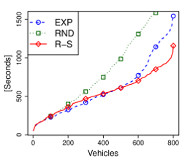
| 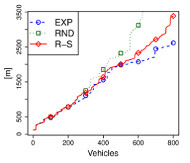
|
Next figure shows fitness values from the experts' solution (EXP) and Red Swarm (R-S) for each pair of instances evaluated. Note that they are sorted by the fitness value of the experts' solution and that the y axis does not start at zero.

Publications:
Daniel H. Stolfi and Enrique Alba. Reducing Gas Emissions in Smart Cities by Using the Red Swarm Architecture. In: Advances in Artificial Intelligence, in Lecture Notes in Computer Science. Berlin, Heidelberg: Springer Berlin Heidelberg, 2013, pp. 289-299.
doi> 10.1007/978-3-642-40643-0_30 | [BibTex] | [Slides] | [Files]@InProceedings{Stolfi2013, author = {Stolfi, Daniel H. and Alba, Enrique}, booktitle = {Advances in Artificial Intelligence}, title = {Reducing Gas Emissions in Smart Cities by Using the Red Swarm Architecture}, year = {2013}, address = {Berlin, Heidelberg}, editor = {Bielza, Concha and Salmer{\'o}n, Antonio and Alonso-Betanzos, Amparo and Hidalgo, J. Ignacio and Mart{\'i}nez, Luis and Troncoso, Alicia and Corchado, Emilio and Corchado, Juan M.}, pages = {289--299}, publisher = {Springer Berlin Heidelberg}, series = {Lecture Notes in Computer Science}, volume = {8109}, doi = {10.1007/978-3-642-40643-0_30}, isbn = {978-3-642-40643-0}, keywords = {Application, Evolutionary Algorithm, Gas Emissions, Road Traffic, Smart City, Smart Mobility}, }
Authors acknowledge funds from the Ministry of Economy and Competitiveness and FEDER under contract TIN2011-28194 (roadME).
Eco-friendly Reduction of Travel Times in European Smart Cities
This article proposes an innovative solution for reducing polluting gas emissions from road traffic in modern cities. It is based on a our new Red Swarm architecture which is composed of a series of intelligent spots having WiFi connections to suggest to drivers a customized route to their destinations. Here, we have tested our proposal in four different case studies corresponding to actual smart cities of Europe. To this end, we first have imported the city information from OpenStreetMap into the SUMO road traffic micro-simulator, proposed a Red Swarm architecture based on intelligent spots located at traffic lights, and then optimized the resulting system in terms of travel times and gas emissions by using an evolutionary algorithm.
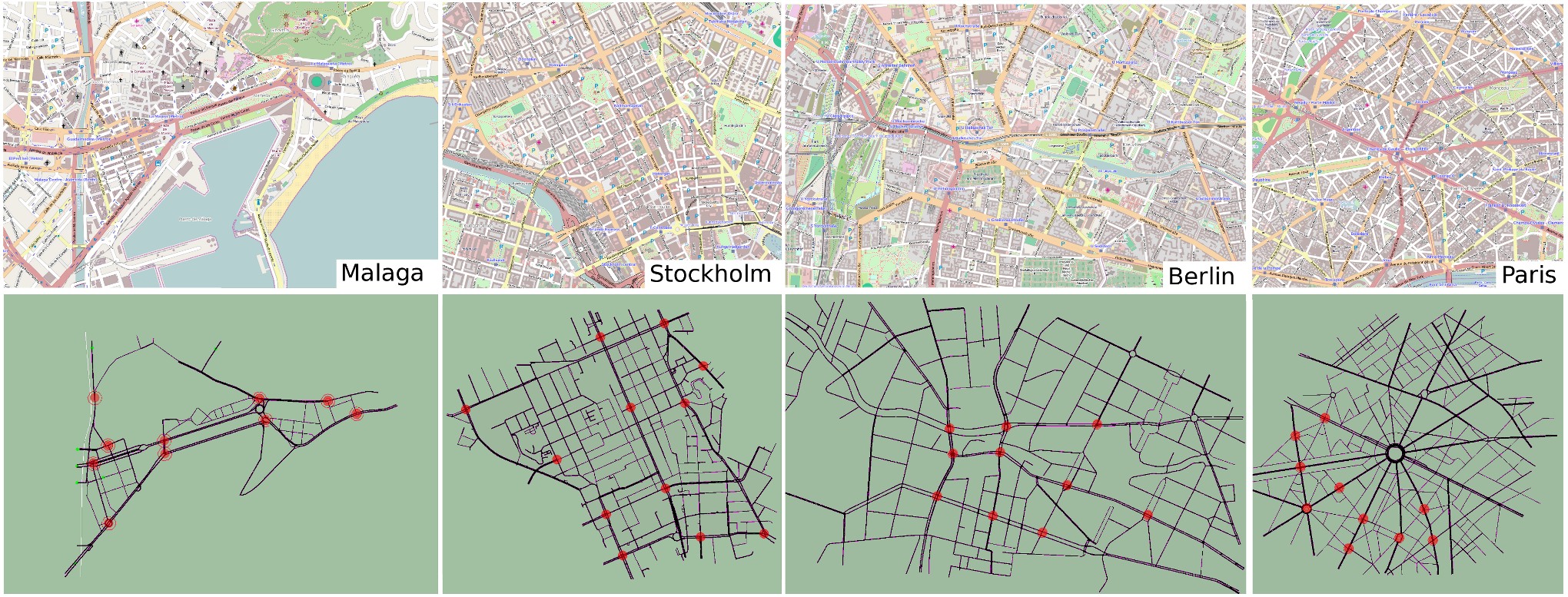
Our results show that an important quantitative reduction in gas emissions as well as in travel times can be achieved when vehicles are rerouted according to our Red Swarm indications. This represents a promising result for its low cost implementation in practice of an idea that could foster both citizens and municipal authorities interests.
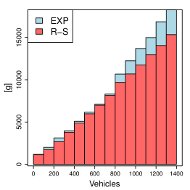
| 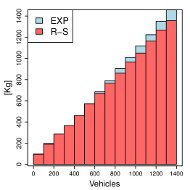
| 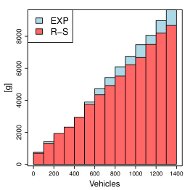
| 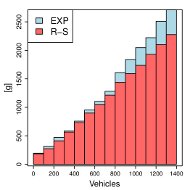
|

| 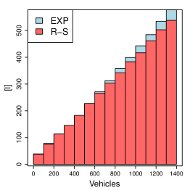
| 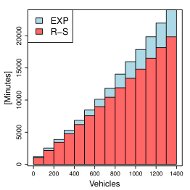
| 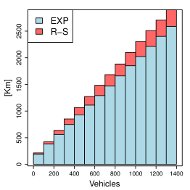
|
Publications:
Daniel H. Stolfi and Enrique Alba. Eco-friendly Reduction of Travel Times in European Smart Cities. In: Proceedings of the 2014 Conference on Genetic and Evolutionary Computation, in GECCO '14. New York, NY, USA: ACM, 2014, pp. 1207-1214.
doi> 10.1145/2576768.2598317 | [BibTex] | [Slides] | [Files]@inproceedings{Stolfi:2014:ERT:2576768.2598317, address = {New York, NY, USA}, author = {Stolfi, Daniel H. and Alba, Enrique}, booktitle = {Proceedings of the 2014 Conference on Genetic and Evolutionary Computation}, doi = {10.1145/2576768.2598317}, isbn = {978-1-4503-2662-9}, keywords = {application,evolutionary algorithm,gas emissions,road traffic,smart city,smart mobility,wifi connections}, pages = {1207--1214}, publisher = {ACM}, series = {GECCO '14}, title = {{Eco-friendly Reduction of Travel Times in European Smart Cities}}, year = {2014}, }
This research was partially funded by the Ministry of Economy and Competitiveness and FEDER under contract TIN-2011-28194 (roadME). It was also partially funded by project number 8.06/5.47.4142 in collaboration with the VSB-Technical University of Ostrava.




